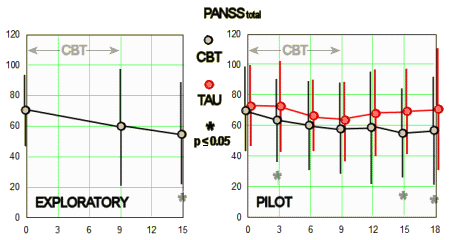When I wrote the last post [a pilot…], I was aware that there had been letters in the Lancet about the Morrison et al article, that I couldn’t access. They’re by statistically much more sophisticated critics than I, but have similar reservations and more. But I wanted to mention the opening to the authors’ reply to the critics:
Authors’ replyOur trial was not designed to change clinical practice. It was a preliminary trial, which needs to be followed up by a larger, pragmatic multicentre study. It is important not to over·interpret our data, and we explicitly advised against discontinuation of medication. We claimed the trial showed that cognitive therapy was safe and acceptable, not safe and effective…
And that’s true – that is exactly what they said at the end of the abstract…
INTERPRETATION: Cognitive therapy significantly reduced psychiatric symptoms and seems to be a safe and acceptable alternative for people with schizophrenia spectrum disorders who have chosen not to take antipsychotic drugs.
…but I didn’t notice that subtle bit of wording the first time around [did you?]. There are some really fine comments to my last post – all worth taking a look at and adding lots of things I hadn’t really thought of. I’m not going to summarize them, but rather suggest you take a look. There’s also an excellent collection of articles on the topic at the Mental Elf – CBTp. I went back and took a look at the prequel, Morrison et al’s exploratory trial prior to this pilot trial:
by A. P. Morrison, P. Hutton, M. Wardle, H. Spencer, S. Barratt A. Brabban, P. Callcott, T. Christodoulides, R. Dudley, P. French, V. Lumley, S. J. Tai and D. TurkingtonPsychological Medicine. 2012 42[05]:1049-1056.
Background Although antipsychotic medication is the first line of treatment for schizophrenia, many service users choose to refuse or discontinue their pharmacological treatment. Cognitive therapy (CT) has been shown to be effective when delivered in combination with antipsychotic medication, but has yet to be formally evaluated in its absence. This study evaluates CT for people with psychotic disorders who have not been taking antipsychotic medication for at least 6 months.Method Twenty participants with schizophrenia spectrum disorders received CT in an open trial. Our primary outcome was psychiatric symptoms measured using the Positive and Negative Syndromes Scale [PANSS], which was administered at baseline, 9 months [end of treatment] and 15 months [follow-up]. Secondary outcomes were dimensions of hallucinations and delusions, self-rated recovery and social functioning.Results T tests and Wilcoxon’s signed ranks tests revealed significant beneficial effects on all primary and secondary outcomes at end of treatmentand follow-up, with the exception of self-rated recovery at end of treatment. Cohen’s d effect sizes were moderate to large [for PANSS total, d=0.85, 95% CI 0.32–1.35 at end of treatment; d=1.26, 95% CI 0.66–1.84 at follow-up]. A response rate analysis found that 35% and 50% of participants achieved at least a 50% reduction in PANSS total scores by end of therapy and follow-up respectively. No patients deteriorated significantly.
Conclusions This study provides preliminary evidence that CT is an acceptable and effective treatment for people with psychosis who choose not to take antipsychotic medication. An adequately powered randomized controlled trial is warranted.
Again, I had trouble reproducing their analyses [and again, access to the raw dataset would’ve been useful to figure out why]. Notice the wording:
Conclusions This study provides preliminary evidence that CT is an acceptable and effective treatment for people with psychosis who choose not to take antipsychotic medication. An adequately powered randomized controlled trial is warranted.
Here is the Primary Outcome variable [PANSStotal] for the two studies [with 95% CI]:

It looks a lot like any number of the Clinical Drug Trials I’ve vetted before. Slim pickings [slim to none]…
As the saying goes, what’s good for the goose is good for the gander. No special pleading allowed. This post confirms that you are an Equal Opportunity Critic.